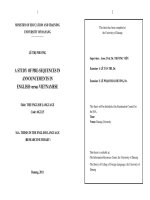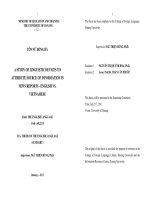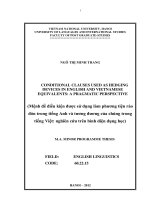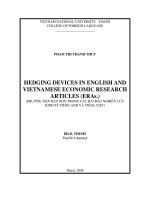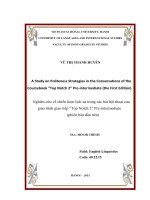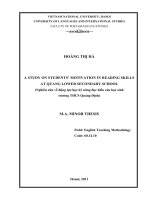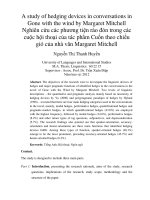a study of hedging devices in conversations in gone with the wind by margaret mitchell = nghiên cứu các phương tiện rào đón trong các cuộc hội thoại của tác phẩm cuốn theo chiều gió của nhà văn margaret mitchell
Bạn đang xem bản rút gọn của tài liệu. Xem và tải ngay bản đầy đủ của tài liệu tại đây (1.22 MB, 52 trang )
VIETNAM NATIONAL UNIVERSITY, HANOI
UNIVERSITY OF LANGUAGES AND INTERNATIONAL STUDIES
FACULTY OF POST-GRADUATE STUDIES
***
NGUYỄN THỊ THANH HUYỀN
A STUDY OF HEDGING DEVICES IN CONVERSATIONS IN GONE WITH
THE WIND BY MARGARET MITCHELL
(Nghiên cứu các phương tiện rào đón trong các cuộc hội thoại của tác phẩm
Cuốn theo chiều gió của nhà văn Margaret Mitchell)
M.A. THESIS
Field: Linguistics
Code: 60.22.15
HANOI – 2012
VIETNAM NATIONAL UNIVERSITY, HANOI
UNIVERSITY OF LANGUAGES AND INTERNATIONAL STUDIES
FACULTY OF POST-GRADUATE STUDIES
*****
NGUYỄN THỊ THANH HUYỀN
A STUDY OF HEDGING DEVICES IN CONVERSATIONS IN GONE WITH
THE WIND BY MARGARET MITCHELL
(Nghiên cứu các phương tiện rào đón trong các cuộc hội thoại của tác phẩm
Cuốn theo chiều gió của nhà văn Margaret Mitchell)
M.A. THESIS
Field: Linguistics
Code: 60.22.15
Supervisor: Assoc. Prof. Dr. TRẦN XUÂN ĐIỆP
HANOI – 2012
iii
TABLE OF CONTENTS
Table of contents iii
List of tables v
List of figures vi
Abbreviations vii
PART 1: INTRODUCTION 1
1. Rationale 1
2. Aims of the research and research questions 2
3. Implications of the research 2
4. Scope of the research 3
5. Methodology 3
6. Research design 4
PART 2: DEVELOPMENT 5
CHAPTER 1 5
Theoretical Background 5
1.1. Definitions of hedge 5
1.2. Classification of hedging devices and hedging functions 6
1.3. Hedges versus conversational maxims and politeness strategies 11
1.4. About Gone with the Wind by Margaret Mitchell 15
1.5. Chapter summary 16
CHAPTER 2 17
Findings and Discussions 17
2.1. Overview of hedging devices in Gone with the Wind by Margaret
Mitchell 17
2.2. Analysis of hedging devices in Gone with the Wind 19
iv
2.2.1. Analysis of modal hedges 19
2.2.2. Analysis of performative hedges 22
2.2.3. Analysis of quantificational hedges 24
2.2.4. Analysis of pragmatic-marker hedges 28
2.2.5. Analysis of tag questions, subjunctives and depersonalization 32
2.3. Functional analysis of hedging devices in Gone with the Wind 34
2.3.1. Speaker-oriented function of hedges 35
2.3.2. Accuracy-oriented function of hedges 36
2.3.3. Hearer-oriented function of hedges 37
PART 3: CONCLUSION 39
1. Recapitulation of main ideas of the research 39
2. Limitations of the study 40
3. Suggestions for further studies 40
REFERENCES 42
v
LIST OF TABLES
Table 1: Taxonomy of hedging devices by Salager-Meyer (1994)
Table 2: Summary of hedging functions and the devices used to express them by
Hyland (1998)
Table 3: Taxonomy of hedging devices by Yu (2009)
Table 4: Hedging devices in conversations in Gone with the Wind
Table 5: Modal hedges: modal aux., modal adv., modal adj., and epistemic lexical
verbs
Table 6: Quantificational hedges: approximators of quantity, frequency, degree,
and ―negation + intensifier‖
Table 7: Pragmatic-marker hedges: interpersonal and propositional
Table 8: Other minor types of hedging devices: subjunctives, tag questions, and
depersonalization
vi
LIST OF FIGURES
Figure 1 Distribution of hedging devices in conversations in Gone with the
Wind
Figure 2 Distribution of modal hedges
Figure 3 Distribution of performative hedges
Figure 4 Distribution of quantificational hedges
Figure 5 Distribution of pragmatic-marker hedges
Figure 6 Distribution of other minor types of hedging devices
Figure 7 Distribution of functions of hedging devices
vii
ABBREVIATIONS
Adj. Adjectives
Adv. Adverbs
IPM Interpersonal pragmatic markers
n Number
p. Page
PPM Proportional pragmatic markers
1
PART 1: INTRODUCTION
This part will briefly present the rationale of the research, indicate the research
purposes and research questions, and finally outline the organization of the study as
a whole.
1. Rationale
It is widely accepted that making frictions in human beings‘ everyday interaction
within a community is almost inevitable. In order to reduce such a friction and
maintain peace and social harmony, there are certain strategies that should be
followed. One of these strategies is ―hedging‖.
Introduced for the first time by Lakoff in 1972, the term of ―hedge‖ was generally
understood as ―words whose job is to make thing fuzzier or less fuzzy‖. Since its
appearance, hedges have received a great deal of attention in conversation analysis
where such devices are used to create conviviality, facilitate discussion, or show
politeness (Holmes, 1984; 1995). Hedging has also been associated with conveying
purposive vagueness (Powell, 1985) and as a means of achieving distance between
the speaker and what is said (Skelton, 1997).
Being an interesting linguistic phenomenon, hedges have been concerned by a
number of linguists. However, as a matter of fact, Yu (2009: 34) indicated that the
majority of hedge studies are found to be concerned with academic or scientific
writing, including genres such as economics (Pindi and Bloor, 1986; Channell,
1990), science digests (Fahnestock, 1986), medical discourse (Salager-Meyer, 1991;
1993; 1994; Adams-Smith, 1984), molecular genetics articles (Myers, 1989), and
news-writing (Zuck & Zuck, 1986; 1987).
The field of spoken discourse, in contrast, seems to receive a comparatively limited
number of comprehensive and thorough investigations. Hence, with the hope of
contributing to enrich the literature of researches on hedging in spoken discourse
and to shed some light on the hedging phenomenon in American everyday
2
conversations by investigating linguistic realization of hedging, pragmatic functions
and some linguistic features of identified hedges, the author of the present paper
decided to carry out the study entitled ―A study of hedging devices in
conversations in Gone with the Wind by Margaret Mitchell‖. In addition to
certain theoretical contributions, the study is expected to have certain implications
in language teaching when various linguistic expressions would be used to serve as
valuable examples for hedging demonstration at work.
2. Aims of the research and research questions
As mentioned earlier, the present research aimed to investigate linguistic devices of
hedging, their linguistic realization and their major pragmatic functions in
conversations in Gone with the Wind by Margaret Mitchell.
The present study attempts to address the following research questions:
What are main hedging devices employed in conversations in Gone with the
Wind by Margaret Mitchell?
What are major functions of identified hedging devices in conversations in
Gone with the Wind by Margaret Mitchell?
3. Implications of the research
Both theoretical and practical implications may be offered by the findings of the
present study. From the theoretical perspective, this study may serve as an
additional source of empirical studies on hedges in a way that it indicated different
types of hedging devices used in everyday conversations to achieve different
pragmatic effects and proved the possibility of utilizing the combined
polypragmatic functions of hedges to investigate hedging phenomenon in spoken
discourse.
In terms of practical perspective, the present study may serve certain samples as a
source of authentic materials in learning and teaching hedging devices and functions
of hedges since a text-based approach is believed to be a key dealing with the lack
3
of pragmatic competence of non-native speakers in communication with native
ones.
4. Scope of the research
First, although communication comes with paralinguistic and extra-linguistic
factors, the present study is restricted to the verbal mode of hedging. That is to say,
the prosodic features (speed, tone, loudness, etc.) and the kinesic mode (facial
expressions, eye contact, etc.) are outside the research scope. Adjacency pairs, in
addition, are also beyond the scope of the investigation.
Second, though pragmatic functions of hedging in spoken discourses are believed to
be realized through different communicative strategies without using hedging
expressions, such as saying sorry, showing regret, expressing interest, and so on,
the present paper is restrained to linguistic realization of hedges, from which the
pragmatic effects of hedges are expected to be portrayed.
5. Methodology
The research is based on a detailed contextual analysis of conversations in the novel
of Gone with the Wind by Margaret Mitchell. A comprehensive understanding of
hedging devices in Gone with the Wind involves at least two levels of linguistic
description: a quantitative analysis and a pragmatic analysis. The process of
analysis is described as follows.
- Quantitative analysis: The purpose of quantitative surface-level analysis is to
generalize the major forms of hedges in conversations. All the indentified items
were scrutinized in their context to select those linguistic categories that express
hedges. At this point, the taxonomy suggested by Yu (2009) was mainly
employed to guide the process of identification of hedging devices in the
conversations in the novel.
- Pragmatic analysis: The research then employed a contextual analysis of
authentic conversations at the second level of analysis to identify the purposes
4
served by identified hedging devices. At this point, the pragmatic analysis was
adapted from the theories introduced by Hyland (1998).
6. Research design
The study is designed to include three main parts.
Part 1: Introduction, presenting the research rationale, aims of the study, research
questions, implications of the research, study scope, methodology and the
structure of the paper.
Part 2: Development
Chapter1: Theoretical Background, including definitions of hedge, hedging
taxonomies, relationship between hedges and conversational maxims and
politeness strategies, and general information on Gone with the Wind.
Chapter 2: Findings and Discussions, describing major hedging devices,
their linguistic realization and pragmatic functions in Gone with the Wind.
Part 3: Conclusion, summarizing the major points, limitations, and suggestions for
further studies.
5
PART 2: DEVELOPMENT
CHAPTER 1
Theoretical Background
This part will briefly present a review of definitions of hedge, hedging taxonomies,
relationship between hedges and conversational maxims and politeness strategies,
literature review of related studies and general information on Gone with the Wind.
1.1. Definitions of hedge
From the explanations above it can be seen that it is rather challenging to state a
definition of hedges incorporating all approaches. Indeed, in the field of hedging
studies related to pragmatics, linguistics, semantics, logics or philosophy, there is
still little clarity and agreement as to what counts as a hedge.
Lakoff (1972: 195), from the point of view of language philosophy, used the term
hedge for the first time to refer to ―words whose job is to make things fuzzier or less
fuzzy‖.
According to Brown & Levinson (1987: 145), hedges are defined as ―a particle,
word or phrase that modifies the degree of membership of a predicate or a noun
phrase in a set; it says of that membership that it is partial or true only in certain
respects, or that it is more true and complete than perhaps might be expected‖
According to Hyland (1998: 5), hedging is ―the means by which writers can present
a proposition as an opinion rather than a fact: items are only hedges in their
epistemic sense, and only when they mark uncertainty‖
To create the theoretical basis and guide the process of realizing and analyzing
hedging devices in this paper, ―hedge‖ is defined in its broad sense, as
encompassing the six aspects recapitulated by Yu (2009: 69) as follows:
6
(1) Hedge as a word, particle or phrase modifying another linguistic unit (such
as a predicate or a noun), category membership, or an element of an
utterance, to make the modified part more vague (in term of face value) or
more precise (in term of the speaker‘s intendment). In this sense, hedge
works rather locally on part of an utterance or proposition.
(2) Hedge performing a speech act, i.e. used as a hedged performative (e.g., I
think/ suppose/ guess that ).
(3) Hedge as a linguistic means modifying the truth value of a whole
proposition, making its content appearing vaguer yet more precise.
(4) Hedge as a linguistic means moderating the speaker‘s attitude or his/her
commitment to the propositional content.
(5) Hedge as a linguistic means that contributes to good interpersonal
relationship, or good interactional behavior in communication.
(6) Hedge performing more social functions such as saving the speaker‘s or the
hearer‘s face, protecting the writer‘s or his/her institution‘s reputation,
projecting the speaker‘s or the writer‘s personality, strengthening solidarity
with the addressee, or gaining ratification from the readers.
1.2. Classification of hedging devices and hedging functions
Concerning the classification of hedging devices, it is widely accepted that ―the
taxonomy of hedges is rather arbitrary, since there are no unified criteria for the
classification of hedges‖ (Yu, 2009: 55). The following is an overview of some
most prominent approaches to classification of hedges and hedging functions
available in the literature.
Salager-Meyer's classification
In 1994 Salager-Meyer developed a five-type taxonomy of hedges which is
presented in Table 1. This taxonomy, according to Crompton (1997: 277),
―attempted to consider both formal and functional criteria‖ of hedges.
7
Type of hedge
Category
Example
1. Shields
- Modal verbs
- Semi-auxiliaries
- Probability adverbs and
adjectives
- Epistemic verbs
- Would, might
- Seem, appear
- Probably, likely
- Suggest, believe
2. Approximators
- Rounders of quantity, degree,
frequency
- Approximately, roughly
3. Personal
expressions
- Expressions of author‘s doubt
and direct involvement
- I believe, in my opinion
4. Emotionally
charged
intensifiers
- Comment words
- Extremely interesting,
- Particularly encouraging
5. Compound
hedges
- Double hedges
- Treble hedges
- Quadruple hedges
- It may suggested that
- It would seem likely that
- It would seem somewhat
unlikely that
Table 1 Taxonomy of hedging devices (adapted from Salager-Meyer, 1994)
The taxonomy of hedges presented above is based on a combination of functional
and syntactic criteria, trying to match grammatical forms with functional categories.
Despite the seeming clearness, the taxonomy was criticized by Varttala (1999), who
discovered the ―obvious overlap between the categories‖ and overlook of the
complex nature of the hedging phenomenon (Varttala, 1999: 181). Nevertheless, the
taxonomy is still widely employed in many studies.
Hyland’s classification
Hyland (1998: 156) argued that because ―hedging devices may convey a range of
meanings for particular users in particular contexts‖, they ―do not fit into a neat
scheme of discrete categories which allows one meaning to be clearly distinguished
from others‖ and ―assigning specific meaning exclusively to particular forms is not
always possible‖ (Hyland, 1996a: 437). Due to the polypragmatic nature of hedging
devices, he developed a fuzzy category model for hedging device, in which two
main categories were mentioned: content-oriented hedges and reader-oriented
hedges.
8
Content-oriented hedges, which are further subdivided into accuracy-oriented
hedges and writer-oriented hedges, serve to mitigate the relationship between
propositional content and a non-linguistic mental representation of reality.
The accuracy-oriented hedges, according to Hyland (1998: 164), refer to writer‘s
desire to express proposition with greater precision through attribute and reliability
hedges. While attribute hedges, represented by such adverbs as quite, almost,
barely, generally, approximately, etc., help writers to specify more accurately how
far their results approximate to an idealized state, the second subtype, reliability
hedges, indicating the amount of writer‘s certainty or uncertainty in a proposition
are presented by modal verbs (e.g. can, could, may, might), modal adjectives (e.g.
possible, likely), modal adverbs (e.g. probably, possibly, maybe, apparently) and
modal nouns (e.g. possibility, probability, chance).
As concerns writer-oriented hedges, Hyland (1998: 170) argued that their aim is to
shield the writer from the possible consequences of negatability by limiting personal
commitment. Writer-oriented function of hedge, therefore, can be realized by
employing the absence of writer agentivity, passive constructions, ―abstract
rhetors‖, epistemic lexical verbs with judgmental and evidential meaning,
attribution to the source of claim, which ―help to minimize writers‘ personal
involvement and allows them to maintain a distance from a proposition‖ (Hyland,
1998: 171).
Along with accuracy-oriented and writer-oriented hedges, Hyland (1998: 182) also
discussed reader-oriented category of hedges, in which the interpersonal interaction
between readers and writers is mostly dealt with by involving the readers in a dialog
and addressing them as a thoughtful individual to respond and judge regarding the
truth value of the proposition. According to Hyland (1998: 184), personal
attribution and reference marked by pronouns such as I, we, my, our are considered
as the main indicators of reader-oriented hedges. Besides the use of personal
pronouns, reader-oriented hedge can be realized through the use of questions,
9
appeals to testability and suggestions of alternatives. The following is a summary of
hedging functions and the devices used to realize them
Content -oriented
Reader-oriented
(Hedges assertiveness)
Accuracy- oriented
(Hedges propositional
content)
Writer-oriented
(Hedges writer
commitment)
1. Attribution type
- Content disjuncts
- Style disjuncts
- Downtoners
2. Reliability type
- Epistemic lexical
verbs
- Modal verbs
- Epistemic adjectives
- Epistemic nouns
- Content disjuncts
1. Epistemic lexical verbs
- Judgmental type
- Evidential type
2. Impersonal
expressions
- Passive voice
- Abstract rhetors
- ―Empty‖ subjects
3. Attribute to literature
4. Reference to method
and model
1. Epistemic lexical
verbs
- Judgmental type
- Deductive type
2. Personal attribution
3. Personal reference to
methods and models
4. Hypotheticals
5. Suggestions of
alternatives
Table 2 Summary of hedging functions and the devices used to express them
(adapted from Hyland, 1998: 186)
Vass’s classification
A model of linguistic analysis proposed by Vass (2004) is organized around three
parameters. The first parameter is verbal and non-verbal lexical items signaling
hedging. The second one is hedging strategies that include indetermination,
depersonalization and subjectivization. The third parameter comprises four
functions, which integrate both ideational and interpersonal components: (1) to
respond to expectations of the discourse community concerning the nature and
uncertainty of knowledge; (2) to prevent and temper possible conflict and negative
reaction; (3) to soften the illocutionary force of one‘s utterance; and (4) to create a
particular impression on the addressee.
Vass has also pointed that the functions can be achieved in a variety of ways,
including ―mitigation of commitment to, or responsibility for, the truth value of
proposition, or the modification of and addresser‘s attitude towards the information
given‖ (Vass, 2004: 132).
10
Paloma’s classification
According to Paloma (2007: 142), hedging is a multi-faceted phenomenon which
can be approached from different points of view and ―hedging is not an inherent
characteristic of a text but rather a product of the communication between the writer
and the reader‖. According to her model, lexico-grammatical items that signal
hedging can be divided into: (1) Verbal items: modal verbs, lexical verbs, passive
voice; (2) Non-verbal items: nouns, adverbs and adjectives expressing uncertainty
or tentativeness. Those hedging devices perform three main functions: (1) to show
deference and politeness towards the audience, which can be achieved by strategies
of depersonalization, deference and solidarity; (2) to protect the author against the
potential negative consequences of being proved wrong achieved by some of the
strategies like tentativeness and justification; (3) to show the degree of precision
achieved by strategies of indetermination.
Yu’s classification
Another approach regarding hedging devices and their functions was proposed by
Yu in 2009. Considering that it is indeed difficult to offer a satisfactory
classification of hedging devices without a careful description of the properties and
characteristics of hedging, Yu (2009: 68) developed a different taxonomy of
hedging devices that is based on the grammatical, semantic and pragmatic
properties of hedging devices. He suggested that from the complex interactions
between grammatical, semantic and pragmatic properties of hedging, it can be
predicted that certain linguistic areas are more likely to be the sources of hedging
than others (Yu, 2009: 77).
Based on exhaustive literature overview, Yu distinguished four broad hedging
categories, namely modal hedges, performative (mental) hedges, pragmatic-marker
hedges, and quantificational hedges. The category of modal hedges includes modal
auxiliary verbs (e.g. may, might, could, can), modal adjectives (e.g. possible, likely,
probable), modal adverbs (e.g. possibly, perhaps, probably, maybe), modal nouns
11
(e.g. possibility, chance). The category of mental hedges is generally represented by
lexical verbs with epistemic meaning (e.g. think, suppose, guess, believe, etc).
Quantificational hedges encompass those devices that indicate quantity, frequency
and degree (e.g. some, about, nearly, approximately, almost, quite, sort of, kind of,
etc.). Pragmatic-marker hedges (implicit hedges), which are ―apparently a feature of
oral rather than written discourse‖ (Yu, 2009: 93), include such expressions as
actually, in fact, generally speaking, in my opinion, for me, in other words, I
suppose, I mean, if you like, you know, etc.
The taxonomy of hedges suggested by Yu (2009) can be summarized as follows.
Hedging Devices
Realized by
Examples
Modal Hedges
- Modal auxiliary verbs
- Modal nouns
- Modal adjectives
- Modal adverbs
- Epistemic lexical verbs
- Could, might
- Possibility, chance
- Possible, likely
- Perhaps, maybe
- Seem, appear
Performative
Hedges
- Lexical verbs with
epistemic meanings
- I think,
- I suppose
Quantificational
Hedges
- Quantity approximators
- Frequency approximators
- Degree approximators
- Negation+intensifier
approximators
- Some, all
- Always, sometimes
- Nearly, around
- Not too much, not enough
Pragmatic-Marker
Hedges
- Pragmatic markers
- If you like, if I may
- Generally speaking, as a
matter of fact
Others
- Tag questions
- Impersonalization
- Subjunctives
- , can you?
- It is said that…
- She suggested that…
Table 3 Taxonomy of hedging devices (adapted from Yu, 2009)
1.3. Hedges versus conversational maxims and politeness strategies
It is widely accepted that communication is held mainly on the human conduct
principles needed to be fulfilled. Those principles are cooperative and politeness
principles.
12
1.3.1. Hedges versus Grice’s Maxims of Conversations
In 1975, Grice proposed that participants in a communicative exchange are guided
by a principle that determines the way in which language is used with maximum
efficiency and effect to achieve rational communication. He called it the
Cooperative Principle:
Make your contribution such as required, at the stage at which it occurs, by the
accepted purpose or direction of the talk exchange in which you are engaged.
(1975: 45)
This cooperative principle is an umbrella term for components that guide how we
communicate. These components are grouped together into four categories, called
the Maxims of Conversation: Maxim of quality (truthfulness), Maxim of quantity
(informativeness), Maxim of relation (relevance), and Maxim of manner
(perspicuity).
Quantity: Make your contribution as informative as required (for the current
purposes of the exchange). Do not make your contribution more
informative than is required.
Quality: Do not say what you believe to be false. Do not say that for which you
lack adequate evidence.
Relation: Be relevant.
Manner: Be perspicuous
Avoid obscurity of expression.
Avoid ambiguity.
Be brief (avoid unnecessary prolixity).
Be orderly.
In real world, speakers do not always abide the four maxims mentioned above. In
other words they often flout and/or hedge the maxims. Flouting the maxims means
that speakers violate the conversational maxims, while hedging the maxims means
that the speakers do not want to be committed on the substance of the utterance.
13
Interestingly, from pragmatics aspects, hedges indicate how Gricean maxims are
observed. According to Fauziyah (2007: 21) with respect to cooperative principles,
hedges are markers tied to the expectation of the maxims of quantity, quality,
manner, and relevance.
Take the following utterance as an example, ―They told me that he was upset.‖ In
this case, if the speaker only says that ―he was upset‖ and does not know for sure if
he was upset, he/she may violate the maxim of quality since he/she lacks the
evidence. Nevertheless, by adding they told me that, the speaker wants to confirm
that he/she is observing the conversational maxim of quality.
It seems that when people are involved in conversations, they not only convey
information, but also verify how informative, true, relevant and perspicuous that
information is.
1.3.2. Hedges versus Politeness Strategies
Politeness is one of the most important aspects of human communication: human
beings can only exist in peace together if certain basic conventions of politeness are
observed. Brown & Levinson (1987) produced the most comprehensive theory of
politeness to date in which the main concept is ―face‖ and politeness strategies.
Defined as the public self image that all rational adult members have when engaged
in spoken interaction, and it must be constantly adhered to, ―face‖ consists of two
related aspects: positive – the positive consistent self-image or personality (crucially
including the desire that this self-image be appreciated and approved of) claimed by
interactants and negative face – the basic claim to territories, personal preserves,
rights to non-distraction, such as to freedom of action and freedom of imposition‖.
Beside the notions of negative and positive face, Brown & Levinson (1987) also
proposed the theories on positive politeness and negative politeness strategies.
Positive politeness is in general a way how to show solidarity and express sympathy
towards the addressee. In other words, positive politeness usually tries to minimize
14
the distance between interactants by expressing friendliness and solid interest in the
hearer's need to be respected. The possible face threat is reduced thanks to the fact
that the speaker desires for at least some of the hearer‘s wants (Brown & Levinson,
1987).
Brown and Levinson‘s negative politeness strategies are redressive actions
addressed towards the hearer‘s negative face (Brown & Levinson, 1978). In other
words, negative politeness enables the speaker to maintain his/her face and avoid
conflicts by distancing the speaker from the hearer, such as in refusal, disagreement,
or critique.
Take the relationship between hedges and politeness strategies into account,
Wilamová (2005) describes hedging devices as the pragmatic markers reinforcing
the impact of the message and hence they appear to be associated mainly with the
negative politeness. Brown & Levinson (1987) also consider hedges as one of the
negative politeness strategies because hedges are used to redress various kinds of
face threatening acts (such as criticism, complaints, requests, suggestions, etc) or to
strengthen the force of other acts that may be seen as beneficial to the addressee
(e.g. promises). In addition, they may also be used to stress speaker‘s commitment
to the truth of their utterance or to suggest that they are not taking full
responsibility for the truth of their utterance, in which case they become simple yet
efficient devices for avoiding disagreement with the addressee. Importantly, hedges
are important devices used in marking topic changes. Such changes are face
threatening and therefore are often done off record, the use of hedging serving
precisely this purpose rather than signaling the speaker‘s lack of confidence. In such
cases hedges redress the imposition on the addressee‘s face perhaps partially
apologize for it (Brown & Levinson, 1987). In a word, hedging falls under the
category of negative politeness, as it distances the speaker from the content of the
utterance and the listeners.
15
In addition, in some cases, hedges appear as ‗interpersonal implicit markers‘ (Yu,
2009) that help to reduce the tension of interpersonal confrontations, or create better
relationship between interlocutors and better environment for conveyance of
propositional contents. In these cases, hedging is considered as a positive politeness
strategy.
1.4. About Gone with the Wind by Margaret Mitchell
Gone with the Wind is a romantic drama and the only novel written by Margaret
Mitchell. It is set in Jonesboro and Atlanta, Georgia during the American Civil War
(1861 – 1865) and Reconstruction, and follows the life of Scarlett O'Hara, from the
utmost luxury to absolute starvation and poverty, and from her innocence to her
understanding and comprehension of life. Winning the 1937 Pulitzer Prize, Gone
with the Wind has been considered to be one of the most popular books of all time.
The follows are a brief introduction into some main novel‘s characters whose
utterances will be extracted as examples in the part of data analysis.
- Scarlett O'Hara: Protagonist and beautiful, willful Southern woman
- Rhett Butler: Scarlett's love interest and third husband
- Ashley Wilkes: The man Scarlett loves, Melanie's husband
- Melanie Hamilton Wilkes: Ashley's wife
- Gerald O'Hara: Scarlett's father
- Ellen O'Hara: Scarlett's mother
- Charles Hamilton: Melanie's brother, Scarlett's first husband
- Frank Kennedy: Scarlett's second husband
- Wade Hampton Hamilton: Son of Scarlett and Charles
- Meade: A doctor in Atlanta
- Pork: The O‘Hara family‘s butler
- Cathleen: Scarlett‘s friend
- Stuart: Scarlett‘s friend
- Old Miss: The O‘Hara family‘s neighbor
16
1.5. Chapter summary
The first chapter has so far reviewed presented existing theoretical foundations
relevant to the topic in question. An overview of the development of the hedging
concept, definitions of hedges, the relationship between hedges and conversational
maxims and politeness strategies have been outlined, followed by discussions on
different classifications of hedging devices and hedging functions and a sketch of
the novel Gone with the Wind written by Margaret Mitchell.
It can be said that the overview of the most prominent theories of hedges has
revealed the complicated nature of hedges, which has resulted in the diversity of
hedging devices and hedging functions suggested by different researchers.
However, as for classification for the present study, it was decided to employ the
model of hedging devices suggested by Yu (2009). The reason such decision comes
from the fact that Yu‘s taxonomy was ―developed on the basis of grammatical,
semantic, and pragmatic properties of hedging devices, which allows to predict that
certain linguistic areas are more likely to be the sources of hedging than the other‖
(Bashanova, 2012: 29). With regards to the taxonomy of hedging functions, it was
decided to adapt Hyland‘s theory, mainly for the fact that it may allow the study to
cover different pragmatic functions of identified hedges and be able to avoid the
overlap of interpretation.
17
CHAPTER 2
Findings and Discussions
Discussing the linguistic realization of hedges and the clear-cut potential taxonomy
of hedging devices, Clemen (1997: 6) comments:
There is no limit to the linguistic expressions that can be considered as hedges […]
no linguistic items are inherently hedges but can acquire this quality depending on
the communicative context or the co-text. This also means that no clear-cut lists of
hedging expressions are possible.
Therefore, discovering the hedging meaning and categorizing linguistic expressions
of hedging in the conversations in Gone with the Wind involves analyzing every
instance in its context, which is a time-consuming and painstaking task.
In this chapter, possible linguistic devices employed to indicate hedging functions
in the conversations in Gone with the Wind by Margaret Mitchell will be presented
and discussed.
2.1. Overview of hedging devices in Gone with the Wind by Margaret
Mitchell
The major hedging categories emerged from the data are shown as follows:
(1) Modal hedges
(2) Performative hedges
(3) Quantificational hedges
(4) Pragmatic-marker hedges
(5) Other minor hedge patterns
Table 4 and Figure 1 presented below indicates the raw number of hedging tokens
and the overall distribution of hedging devices by category in the conversations in
Gone with the Wind.
18
Table 4 Hedging devices in conversations in Gone with the Wind
Category
Raw number
%
Modal hedges
1184
34.8
Performative hedges
279
8.2
Quantificational hedges
1488
43.8
Pragmatic-marker hedges
254
7.5
Others
193
5.7
Total
3398
100
Figure 1 Distribution of hedging devices in conversations in Gone with the
Wind
As can be seen, there is a total 3389 items in the conversations of the novel
employed as hedging devices to form four primary types of hedges, namely, modal
hedges, performative hedges, quantificational hedges, and pragmatic-marker
hedges. Among them, quantificational hedges (n = 1488) are identified to be the
most prominent category, accounting for 43.8%, followed by modal hedges
(34.8%), performative hedges (8.2%), pragmatic-marker hedges (7.5%) and other
minor categories (5.7%)
